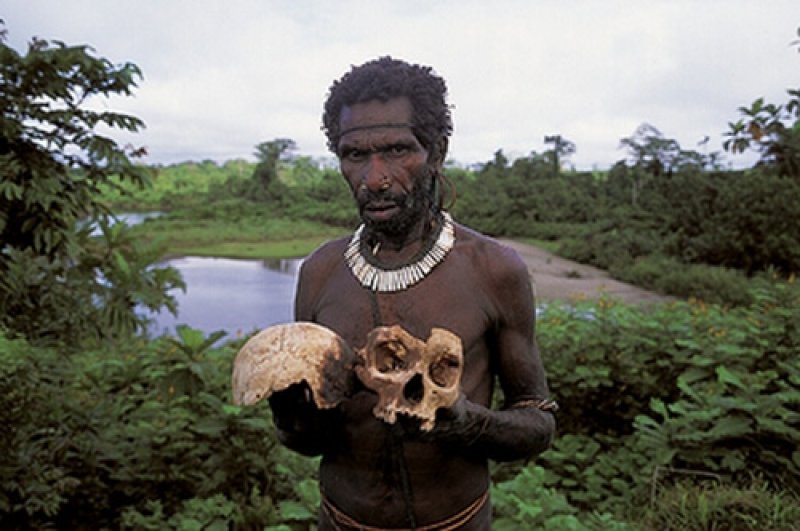“The Cure for Dementia: Eating Brains?” asked the Daily Beast. “How a history of eating human brains protected this tribe from brain disease” read the headline in the Washington Post. The Guardian ran a similar headline “Eating human brains helped Papua New Guinea tribe resist disease, research shows” for a Reuters wire article.
As eye catching as these headlines were, they were incorrect.
[Update: After this study was reported, I contacted the author of the Daily Beast article. The headline was changed after this piece was published. I have revised the title of this piece to reflect the change]
The Fore people, a tribe in Papa New Guinea became infamous for their practice of eating brains. In the 1950s a strange neurological disease started becoming widespread amongst these people that proved to be fatal to a large portion of the population.
The disease, called Kuru was eventually identified as being related to Crutzfelt Jakob Disease (CJD) a rare disease caused by improperly folded proteins called prions. Research showed that the practice of cannibalism practiced by the Fore in which members of the tribe ate the brains of the deceased as a part of a funeral ritual, led to the rapid spread of kuru among the population.
The prion hypothesis of disease which was later proven, was proposed in part based on studies of how kuru spread among the Fore and it won the 1997 Nobel Prize in Medicine.
Protective mutations that are naturally enriched in certain populations are nothing new. In fact, it is why some African populations continue to carry the genetic trait for sickle cell anemia despite it being a debilitating and potentially fatal disease – the sickle cell trait protects them against malaria which is endemic to the region. More recently, researchers found that genetic mutations causing a rare devastating condition called Neimann Pick Disease Type C (NPC) protected against another almost certainly fatal infectious disease. As David Warmflash pointed out in this Genetic Literacy Project article,
But NPC may have a “silver lining” for science; its victims cannot catch the Ebola virus. That’s because Ebola and related viruses require the cholesterol transporter protein that doesn’t work if the NPC gene is defective. According to a study published in Nature, the virus needs the protein in order to makes [sic] its entrance into human cells.
Natural selection of mutations that allow humans to process lactose is also thought to be why we developed lactose tolerance, allowing us to take advantage of a nutritious and easily available source of energy.
What the recent study in Nature discovered and what articles reporting on it should have mentioned is that researchers identified a naturally occurring mutation in the prion protein among certain people in the tribe who had survived the kuru epidemic. Testing the same mutation in mice, they found that it all but prevented the accumulation of the deadly prion proteins. The scientists surmised that this mutation had conferred a protective effect against the disease, a powerful discovery that could help us understand prion diseases like CJD and other neurological disorders like Alzheimer’s in which improper accumulation of proteins is thought to play a role.
Mutations like these and the ones for lactose tolerance arise spontaneously. Because they offer a survival advantage, which in the case of kuru was immediate and significant, the mutation is enriched in the population – simply because individuals who don’t have it are more likely to die.
To imply however, that the mutation was caused by eating brains is not only incorrect but also misleading. It is near impossible to trace the source of why or how the mutation occurred. Articles like the ones in Nature and Gizmodo avoid this folly. However many, including The Washington Post, seemed to have missed the point.
Arvind Suresh is a science media liaison at the Genetic Expert News Service. He is also a science communicator and a former laboratory biologist. Follow him @suresh_arvind.
Additional Resources
- Evolution is weird: Killer diseases save lives and make us smarter? Genetic Literacy Project
- Cancer, bad luck and some lessons in science reporting, Genetic Literacy Project
- Can chemicals evolve? Testing recipes for the origin of life, Genetic Literacy Project
Disclosure: Arvind Suresh is a member of the staff at GENeS which provides rapid access to scientific expertise and opinion on the latest genetics and biotechnology news. GENeS is an independent project affiliated with the World Food Center Institute for Food and Agricultural Literacy at University of California, Davis and funded in part by the Genetic Literacy Project. For more information see our website. The opinions expressed in this article are solely mine and do not reflect those of GENeS.































